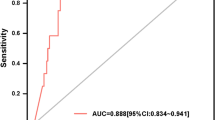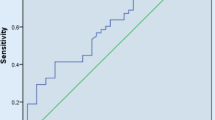Summary
Background
Recently it has been found that BNP and NT–proBNP provide independent prognostic information in patients with acute coronary syndromes (ACS). However, little data are available on the time course of NT–proBNP levels in relation to onset of symptoms.
Methods and results
We included 765 patients (236 females, aged 64 ± 11 years) with an ACS (STEMI 42%, NSTEMI 41%, UAP 17%), who were referred for coronary angiography. NT–proBNP was assessed on admission and the next day. NT–proBNP values were related to the time duration from onset of symptoms until blood drawing with lowest values within 3 h and highest values 24–36 h after onset of symptoms (147 (64–436) pg/ml and 1099 (293–3795) pg/ml, respectively, p < 0.001). Highest values for NT–proBNP on admission were found in patients with NSTEMI compared to patients with STEMI and UAP (912 (310–2258) pg/ml) vs 262 (85–1282) pg/ml) vs 182 (74– 410) pg/ml; p < 0.001), but no difference was present between STEMI and NSTEMI the day after admission (1325 (532–2974) pg/ ml vs 1169 (555–3413) pg/ml; p = 0.676). In contrast NT–proBNP values remained unchanged in UAP (182 (74–410) pg/ml) vs 171 (53–474) pg/ml).
Conclusion
The time interval from onset of symptoms to first blood collection is an important determinant for NT–proBNP values on admission in patients with an ACS and needs to be considered in clinical practice.
Similar content being viewed by others
References
Mair J, Hammerer–Lercher A, Puschendorf B (2001) The impact of cardiac natriuretic peptide determination on the diagnosis and management of heart failure. Clin Chem Lab Med 39:571–588
Mantymaa P, Vuolteenaho O, Marttila M, Ruskoaho H (1993) Atrial stretch induces rapid increase in brain natriuretic peptide but not in atrial natriuretic peptide gene expression in vitro. Endocrinology 133:1470–1473
Richards AM, Doughty R, Nicholls MG, MacMahon S, Sharpe N, Murphy J, Espiner EA, Frampton C, Yandle TG (2001) Plasma N–terminal probrain natriuretic peptide and adrenomedullin: prognostic utility and prediction of benefit from carvedilol in chronic ischemic left ventricular dysfunction. Australia–New Zealand Heart Failure Group. J Am Coll Cardiol 37:1781–1787
Hartmann F, Packer M, Coats AJ, Fowler MB, Krum H, Mohacsi P, Rouleau JL, Tendera M, Castaigne A, Anker SD, Amann–Zalan I, Hoersch S, Katus HA (2004) Prognostic impact of plasma N–terminal pro–brain natriuretic peptide in severe chronic congestive heart failure: a substudy of the Carvedilol Prospective Randomized Cumulative Survival (COPERNICUS) trial. Circulation 110:1780–1786
Hunt PJ, Richards AM, Nicholls MG, Yandle TG, Doughty RN, Espiner EA (1997) Immunoreactive amino–terminal pro–brain natriuretic peptide (NT–PROBNP): a new marker of cardiac impairment. Clin Endocrinol 47:287–296
Post F, Peetz D, Knoess P, Rupprecht HJ (2004) Brain–natriuretic–peptide (BNP) for improvement of the diagnostic determination in a conserving emergency room. Z Kardiol 93(Suppl 4):IV31–35
Bibbins–Domingo K, Ansari M, Schiller NB, Massie B, Whooley MA (2003) B–type natriuretic peptide and ischemia in patients with stable coronary disease: data from the Heart and Soul study Circulation 2987–2992
Weber M, Dill T, Arnold R, Rau M, Ekinci O, Muller KD, Berkovitsch A, Mitrovic V, Hamm C (2004) N–terminal B–type natriuretic peptide predicts extent of coronary artery disease and ischemia in patients with stable angina pectoris. Am Heart J 148:612–620
Goetze JP, Christoffersen C, Perko M, Arendrup H, Rehfeld JF, Kastrup J, Nielsen LB (2003) Increased cardiac BNP expression associated with myocardial ischemia. Faseb J 17:1105– 1107
Hama N, Itoh H, Shirakami G, Nakagawa O, Suga S, Ogawa Y, Masuda I, Nakanishi K, Yoshimasa T, Hashimoto Y et al (1995) Rapid ventricular induction of brain natriuretic peptide gene expression in experimental acute myocardial infarction. Circulation 92:1558–1564
Baxter GF (2004) Natriuretic peptides and myocardial ischaemia. Basic Res Cardiol 99:90–93
Baxter GF (2004) The natriuretic peptides. Basic Res Cardiol 99:71–75
de Lemos JA, Morrow DA (2003) Combining natriuretic peptides and necrosis markers in the assessment of acute coronary syndromes. Rev Cardiovasc Med 4 (Suppl 4):S37–46
James SK, Lindahl B, Siegbahn A, Stridsberg M, Venge P, Armstrong P, Barnathan ES, Califf R, Topol EJ, Simoons ML, Wallentin L (2003) N–terminal pro–brain natriuretic peptide and other risk markers for the separate prediction of mortality and subsequent myocardial infarction in patients with unstable coronary artery disease: a Global Utilization of Strategies To Open occluded arteries (GUSTO)–IV substudy. Circulation 108:275–281
Jaffe AS, Katus H (2004) Acute coronary syndrome biomarkers: the need for more adequate reporting. Circulation 110:104–106
Heeschen C, Hamm CW, Mitrovic V, Lantelme NH, White HD (2004) Nterminal pro–B–type natriuretic peptide levels for dynamic risk stratification of patients with acute coronary syndromes. Circulation 110:3206– 3212
Jernberg T, Stridsberg M, Venge P, Lindahl B (2002) N–terminal pro brain natriuretic peptide on admission for early risk stratification of patients with chest pain and no ST–segment elevation. J Am Coll Cardiol 40:437–445
Alpert JS, Thygesen K, Antman E, Bassand JP (2000) Myocardial infarction redefined – a consensus document of The Joint European Society of Cardiology/American College of Cardiology Committee for the redefinition of myocardial infarction J Am Coll Cardiol, pp 959–969
Hamm CW, Braunwald E (2000) A classification of unstable angina revisited 118–122
The Thrombolysis in Myocardial Infarction (TIMI) trial (1985) Phase I findings. TIMI Study Group. N Engl J Med 312:932–936
Tateishi J, Masutani M, Ohyanagi M, Iwasaki T (2000) Transient increase in plasma brain (B–type) natriuretic peptide after percutaneous transluminal coronary angioplasty. Clin Cardiol 23:776–780
Morita E, Yasue H, Yoshimura M, Ogawa H, Jougasaki M, Matsumura T, Mukoyama M, Nakao K (2000) Increased plasma levels of brain natriuretic peptide in patients with acute myocardial infarction. Circulation 88:82–91
Gill D, Seidler T, Troughton R, Yandle TG, Frampton C, Richards AM, Lainchbury JG, Nicholls MG (2004) Vigorous response in plasma N–terminal pro–brain natriuretic peptide (NT–BNP) to acute myocardial infarction. Clinical Science 106:135–139
Lindahl B, Lindback J, Jernberg T, Johnston N, Stridsberg M, Venge P, Wallentin L (2005) Serial analyses of N–terminal pro–B–type natriuretic peptide in patients with non–ST–segment elevation acute coronary syndromes: a Fragmin and fast Revascularisation during In Stability in Coronary artery disease (FRISC)–II substudy. J Am Coll Cardiol 45:533–541
Bassan R, Potsch A, Maisel A, Tura B, Villacorta H, Nogueira MV, Campos A, Gamarski R, Masetto AC, Moutinho MA (2005) B–type natriuretic peptide: a novel early blood marker of acute myocardial infarction in patients with chest pain and no ST–segment elevation. Eur Heart J 26:234–240
Larsen AI, Dickstein K (2004) BNP in acute coronary syndromes: the heart expresses its suffering. Eur Heart J 25:1284–1286
Galvani M, Ottani F, Oltrona L, Ardissino D, Gensini GF, Maggioni AP, Mannucci PM, Mininni N, Prando MD, Tubaro M, Vernocchi A, Vecchio C (2004) N–terminal pro–brain natriuretic peptide on admission has prognostic value across the whole spectrum of acute coronary syndromes. Circulation 110:128–134
Sabatine MS, Morrow DA, de Lemos JA, Omland T, Desai MY, Tanasijevic M, Hall C, McCabe CH, Braunwald E (2004) Acute changes in circulating natriuretic peptide levels in relation to myocardial ischemia. J Am Coll Cardiol 44:1988–1995
Tanaka T, Kanda T, Takahashi T, Saegusa S, Moriya J, Kurabayashi M (2004) Interleukin–6–induced reciprocal expression of SERCA and natriuretic peptides mRNA in cultured rat ventricular myocytes. J Int Med Res 32:57–61
Loke I, Squire IB, Davies JE, Ng LL (2003) Reference ranges for natriuretic peptides for diagnostic use are dependent on age, gender and heart rate. Eur J Heart Fail 5:599–606
Redfield MM, Rodeheffer RJ, Jacobsen SJ, Mahoney DW, Bailey KR, Burnett JC Jr (2002) Plasma brain natriuretic peptide concentration: impact of age and gender. J Am Coll Cardiol 40:976–982
Weber M, Arnold R, Rau M, Brandt R, Berkovitsch A, Mitrovic V, Hamm C (2004) Relation of N–terminal pro–B–type natriuretic peptide to severity of valvular aortic stenosis. Am J Cardiol 94:740–745
Author information
Authors and Affiliations
Corresponding author
Rights and permissions
About this article
Cite this article
Weber, M., Kleine, C., Keil, E. et al. Release pattern of N–terminal pro B–type natriuretic peptide (NT–proBNP) in acute coronary syndromes. Clin Res Cardiol 95, 270–280 (2006). https://doi.org/10.1007/s00392-006-0375-x
Received:
Accepted:
Published:
Issue Date:
DOI: https://doi.org/10.1007/s00392-006-0375-x




